Biology
Duke University
Popular textbooks · Show all (10) Hide
All books 10 HideAll 62 results
Sort by
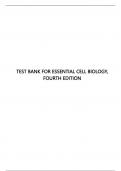
-
TEST BANK FOR ESSENTIAL CELL BIOLOGY, FOURTH EDITION
- Exam (elaborations) • 31 pages • 2023
-
- $10.00
- + learn more
Page 2 of 31 CHAPTER 3: ENERGY, CATALYSIS, AND BIOSYNTHESIS © 2014 GARLAND SCIENCE PUBLISHING The Use of Energy by Cells 3-1 Chemical reactions carried out by living systems depend on the ability of some organisms to capture and use atoms from nonliving sources in the environment. The specific subset of these reactions that break down nutrients in food can be described as _____________. (a) metabolic. (b) catabolic. (c) anabolic. (d) biosynthetic. 3-2 When there is an excess of nutri...
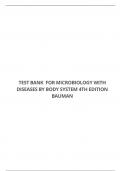
-
TEST BANK FOR MICROBIOLOGY WITH DISEASES BY BODY SYSTEM 4TH EDITION BAUMAN
- Exam (elaborations) • 16 pages • 2023
-
- $10.00
- + learn more
Chapter 1 A Brief History of Microbiology 1.1 Multiple-Choice Questions 1) Antoni van Leeuwenhoek was the first person in history to A) use a magnifying glass. B) develop a taxonomic system. C) view protozoa and bacteria. D) disprove spontaneous generation. E) prove the germ theory. Answer: C Bloom's Rank: Knowledge Section: The Early Years of Microbiology 2) The microbes commonly known as __________ are single-celled eukaryotes that are generally motile. A) archaea B) bacteria C...
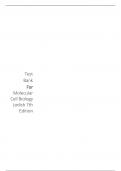
-
Test Bank For Molecular Cell Biology Lodish 7th Edition
- Exam (elaborations) • 7 pages • 2023
-
- $10.00
- + learn more
2 - 2 Chemical Foundations PART A: Linking Concepts and Facts 2.1 Covalent Bonds and Noncovalent Interactions 1. Covalent bonds between which of the following pairs of atoms are nonpolar? a. C–C b. C–H c. O–H d. a and b Ans: d 2. Which of the following is a noncovalent interaction? a. hydrophobic effect b. ionic interactions c. Van der Waals interactions d. all of the above Ans: e 3. Which of the following is the strongest interaction? a. hydrogen bond b. ionic bond c. p...
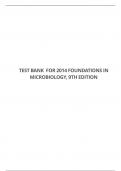
-
TEST BANK FOR 2014 FOUNDATIONS IN MICROBIOLOGY, 9TH EDITION
- Exam (elaborations) • 29 pages • 2023
-
- $10.00
- 1x sold
- + learn more
Chapter 03 - Tools of the Laboratory: Methods of Studying Microorganisms Chapter 03 Tools of the Laboratory: Methods of Studying Microorganisms Multiple Choice Questions 1. The Six I's of studying microorganisms include all of the following except A. inoculation. B. incubation. C. infection. D. isolation. E. identification. ASM Objective: 07.01b Ability to apply the process of science: Analyze and interpret results from a variety of microbiological methods and apply these methods to ...
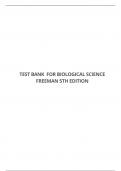
-
TEST BANK FOR BIOLOGICAL SCIENCE FREEMAN 5TH EDITION
- Exam (elaborations) • 20 pages • 2023
-
- $10.00
- + learn more
Biological Science, 5e (Freeman) Chapter 14 Mendel and the Gene 1) The work of Gregor Mendel provided an answer to two prevailing hypotheses popular at the time. What were these two hypotheses? A) Mitosis is only typical in vertebrates. Meiosis is only typical in invertebrates. B) The two major hypotheses of the time were blending inheritance and inheritance of acquired characteristics. C) Animals use one set of rules for inheritance, while plants use a different set. D) Peas and other d...
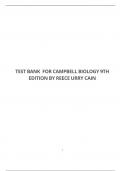
-
TEST BANK FOR CAMPBELL BIOLOGY 9TH EDITION BY REECE URRY CAIN
- Exam (elaborations) • 9 pages • 2023
-
- $10.00
- + learn more
Campbell's Biology, 9e (Reece et al.) Chapter 1 Introduction: Themes in the Study of Life This introductory chapter explores the basic themes and concepts of biology, with emphasis on the core theme of evolution. It also introduces students to the thinking of scientists. Questions are therefore general; however, an effort has been made to include some from each skill level. As in the rest of this test bank, questions that feature art or those for which several questions follow upon some da...
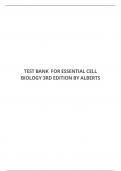
-
TEST BANK FOR ESSENTIAL CELL BIOLOGY 3RD EDITION BY ALBERTS
- Exam (elaborations) • 13 pages • 2023
-
- $10.00
- + learn more
CHAPTER 1 INTRODUCTION TO CELLS 2009 Garland Science Publishing 3rd Edition Unity and Diversity of Cells 1-1 The smallest unit of life is a(n) (a) DNA molecule. (b) cell. (c) organelle. (d) virus. (e) protein. 1-2 For each of the following sentences, fill in the blanks with the best word or phrase selected from the list below. Not all words or phrases will be used; each word or phrase should be used only once. Cells can be very diverse: superficially, they come in various sizes, ra...
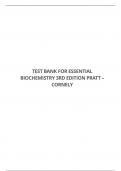
-
TEST BANK FOR ESSENTIAL BIOCHEMISTRY 3RD EDITION PRATT – CORNELY
- Exam (elaborations) • 8 pages • 2023
-
- $10.00
- + learn more
Package Title: Pratt & Cornely Test Bank Course Title: Pratt & Cornely Chapter Number: 1 Question type: Multiple Choice 1) Which of the following is the most abundant element in the human body? A) nitrogen B) carbon C) oxygen D) phosphorous E) none of the above Answer: B Difficulty: Easy Section Reference: 1-2 Learning Objective: Distinguish the four main types of biological molecules and their polymers 2) Of the following amino acids, which contains an alcohol? a b c d A) a B) ...
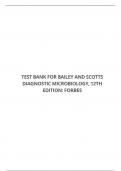
-
TEST BANK FOR BAILEY AND SCOTTS DIAGNOSTIC MICROBIOLOGY, 12TH EDITION: FORBES
- Exam (elaborations) • 5 pages • 2023
-
- $10.00
- + learn more
Forbes: Bailey & Scott's Diagnostic Microbiology, 12th Edition Test Bank Chapter 1: Microbial Taxonomy MULTIPLE CHOICE 1. Taxonomy can be described as a. a consistent means to classify, name, and identify organisms. b. the common language in science that minimizes confusion about names. c. the naming system that allows scientific attention to center on more important issues and phenomena. d. playing a central role in providing accurate and timely diagnosis of infectious diseases. e. ...

-
TEST BANK FOR BASIC IMMUNOLOGY, 3RD EDITION: ABUL K. ABBAS
- Exam (elaborations) • 8 pages • 2023
-
- $10.00
- + learn more
Test Bank 1-2 Abbas: Basic Immunology, 3rd Updated Edition Chapter 01: Introduction to the Immune System Test Bank MULTIPLE CHOICE 1. The principal function of the immune system is: A. Defense against cancer B. Repair of injured tissues C. Defense against microbial infections D. Prevention of inflammatory diseases E. Protection against environmental toxins ANS: C The immune system has evolved in the setting of selective pressures imposed by microbial infections. Although immune resp...

Did you know that on average a seller on Stuvia earns $82 per month selling study resources? Hmm, hint, hint. Discover all about earning on Stuvia




